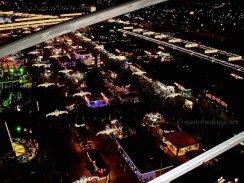
Over the past couple of days, various festivities in honour of the Virgen del Carmen, the patron saint of fishermen and sailors, have been in full swing.
Around 16th July each year, many of the coastal towns and fishing villages of Spain celebrate by parading the statue of Virgin del Carmen through the streets, accompanied by the steady rhythm of a brass band, the resounding thump of a drumbeat and the cries from the crowd of “guappa” or “viva” as the statue passes by.
At dusk, after the procession arrives at the water’s edge, the Virgin del Carmen is taken out to sea on a flower-decked boat, accompanied by a flotilla of fishing boats (jábegas),to bless their fishing grounds.
The Virgen del Carmen is of great importance to the inhabitants of Axarquían towns and villages such as Caleta de Vélez, Nerja, Rincón de la Victoría and Torre del Mar because many larger towns and holiday resorts along the coast were once small fishing villages where the sea provided their daily existence.
But we need to look back to the scriptures of the Old Testament, centuries before the birth of Christ, for the origin of the Virgen del Carmen.
The Bible tells us that the prophet Elijah went up Mount Carmelo near Haife, in Israel to pray for rain to relieve a great drought that had parched the lands. Whilst Elijah was on Mount Carmelo, he saw white clouds forming, which would bring the much needed rain. Elijah interpreted the clouds as a sign of the coming of a Saviour who would be born of a Virgin.
In gratitude for the rain, the community dedicated itself to praying for the mother of the Saviour to come, and the Order of the Carmelites was formed.
On 16th July 1251, the Virgen del Carmen is said to have appeared to Englishman, Simon Stock, who was responsible for building Carmelite monasteries throughout Europe in the 13th century. The story goes that when she appeared to him, the Virgen was holding a scapular and she promised that Carmelites who show their devotion should use this as a sign of privilege that they would be “granted the grace of final perseverance and be delivered from eternal Purgatory”.

A scapular was originally an apron, forming part of the dress of a religious order, but for the lay-faithful, scapulars usually bear images, or verses from scripture. Devotional scapulars typically consist of two rectangular pieces of cloth, wool or other fabric that are connected by bands. One rectangle hangs over the chest of the wearer, while the other rests on the back, with the bands running over the shoulders.
The Virgin Mary of Mount Carmelo (the Virgin of Carmen or Virgen del Carmen) is also known as Stella Maris (Latin for Star of the Sea) which is the name given to the Pole Star (Polaris) used by mariners for centuries as celestial navigation.
EDITED TO ADD: These photos were all taken during the evening of 16th July 2014 in Torre del Mar. I had to wade out into the sea, above my knees, to take them because there were so many people on the beach, it was the only way of getting the chance of some good shots without thousands of heads or bodies in the way. My sundress was soaked and I had to try to hold it up with one hand and take photos with my other. Happy days 🙂
Which is your favourite Spanish festival?
















































